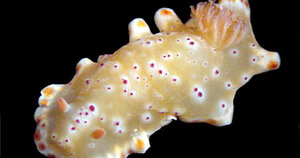Want to name a sea slug? A nonprofit might let you.
To raise cash, some science and environmental groups will let donors name species for a fee.

For $15,000, you could name this sea slug.
Scripps Institution of Oceanography
San Diego
Forget about getting a building named after yourself. The cash-strapped Scripps Institution of Oceanography is offering what might be an even better deal to someone looking to make a mark in history: A rare hydrothermal vent worm will forever be emblazoned with your name if you fork over $50,000.
For those on a smaller budget, a mere $15,000 will land you in the annals of marine biology as the namesake of an orange, speckled nudibranch, also known as a sea slug.
Across the world, “name a species” fundraisers are spreading into a variety of scientific fields. In recent years, donors have vied for the rights to grant names to frog and shark species, among others.
To supporters, naming programs are appropriate ways to raise money and draw attention to science during times of major financial stress. But critics see plenty of potential for abuse.
“There are concerns that profiteering is inappropriate,” says Joe Mendelson, curator of herpetology, the study of reptiles and amphibians, at Zoo Atlanta. “There are people out in the taxonomy community who say as soon as there’s money involved, this is flat-out wrong.”
So far, profits from name-a-species promotions have run the gamut from huge to modest. The biggest bounties came in 2005, when an online casino donated $650,000 to name a monkey species, and last year, an ocean-species naming auction in Monaco raised $2 million for research. The African nation of Rwanda, meanwhile, raises funds through a high-profile program that names individual gorillas each year.
At least one other fundraiser is struggling, however. Amphibian Ark, a preservation organization, has been disappointed by its efforts to auction the rights to name frog species. One online auction last month raised just $5,500, says program director Kevin Zippel, while this month’s has only reached $2,000 so far. “We desperately need money to try to save amphibian species,” says Mr. Zippel, who points to estimates suggesting 2,000 to 3,000 of the species are in danger of extinction. “We’re looking at all the options that are open to us.”
While federal support for science has remained steady since 2004, reaching $57.4 billion this year, it’s actually gone down when inflation is taken into account, says Kei Koizumi, director of the American Association for the Advancement of Science’s R&D budget and policy program. “Every year there’s a little scr less money to go around,” he says.
“Institutions that rely on federal funds to keep their research going are finding it much tougher to get that money and are having to get creative in either finding other sources or rethinking what kinds of research they do.”
At Scripps Institution, part of the University of California, San Diego, state cutbacks to research funding forced officials to eliminate the $300,000 in annual funding for its libraries of preserved collections, says Lawrance Bailey, senior director of development. The other alternative was to cut staff.
The libraries hold millions of sea creatures, rocks, and fossils. To keep the libraries functioning and accepting new specimens, the institution turned to fundraising. But thousands of preserved species “aren’t as sexy as funding an expedition or a project to address climate change,” Mr. Bailey says.
Enter the name-a-species program, despite the objections of some older Scripps scientists who “felt that this was selling out, that to name a species in return for a gift was tasteless at a minimum,” he says.
Scientists often name species after a trait like color or habitat, but they have a long history of naming species after each other – although self-naming is frowned upon – or for friends and family. Greg Rouse, professor of marine biology at Scripps Institution, says he recently named a sea worm Mesonerilla neridae after his girlfriend, Nerida. It may not sound like a traditional romantic gesture, but “she really liked it,” he says. “She was there when we discovered it.”
Famous people get their share of names too. For example, a pair of US entomologists named three slime-mold beetle species after George W. Bush, Dick Cheney, and Donald Rumsfeld, former secretary of defense. It wasn’t a joke: Mr. Bush called to thank one of the entomologists, who said he wished to honor the three men.
Several spiders are named for Orson Welles movies, while another spider has the cinematic name of Apopyllus now.
At Scripps Institution, naming rights to three worms have sold so far, one for $10,000 and two for $5,000. The buyers include a high school teacher, a local branch of a telephone manufacturer, and a woman who bought the name as an anniversary gift for her husband.
A total of $20,000 in donations may not seem like much. But Bailey isn’t discouraged. “Considering that we’re naming lowly invertebrates,” he says, “I think we’ve done OK.”
